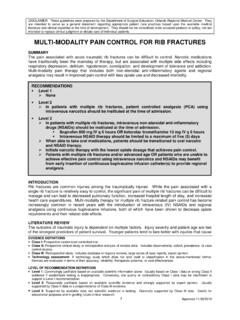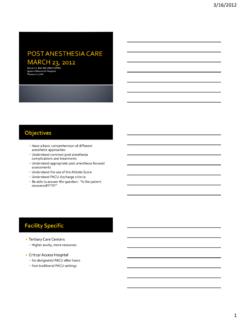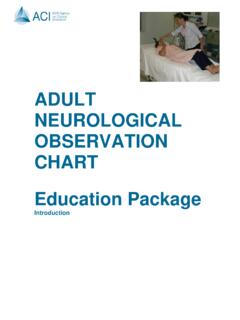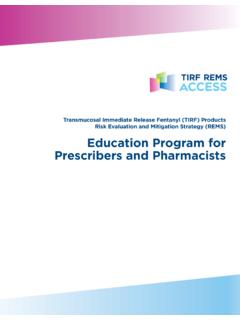Transcription of Moderate Sedation: Risks and Challenges - - RN.org®
1 Moderate sedation : Risks and Challenges Reviewed May, 2017, Expires May, 2019 Provider Information and Specifics available on our Website Unauthorized Distribution Prohibited Developed by Melissa K Slate, RN, CRN 2017 , , , Objectives By the end of this exercise, the clinician will be able to: 1. Discuss the evolution of Moderate sedation 2. Identify Risks and complications of Moderate sedation 3. Apply principles of nursing care to moderately sedated patients Moderate sedation is known by many different names: conscious sedation , procedural anesthesia, analgesia, or sedation . The need for Moderate levels of sedation has increased due to the ever-expanding rate of outpatient procedures being performed, such as colonoscopies and endoscopies. The development of less invasive procedures, has also increased the demand for Moderate sedation , as more and more patients are receiving medical care, minor to Moderate surgeries, and diagnostic exams without ever spending time as an inpatient.
2 Most colonoscopies and endoscopies are performed without the presence of a full surgical team; the physician performing the procedure is most frequently responsible for the administration of anesthesia prior to or during the procedure. This has lead to quite a bit of controversy within the field of anesthesia. Moderate sedation is defined as a state that closely resembles deep relaxation in which the patient should still be able to respond purposefully to verbal or light stimulus, yet still maintain adequate ventilation and airway management (Baxter, 2008). However, some physicians who thought that they were practicing Moderate sedation were actually practicing deep sedation with the potential of airway compromise and apnea for the patient (Egan, 2007). While not always the case, most generally Moderate sedation is achieved when speech becomes slurred. The American Association of Anesthesiologists has recommended that all persons involved with the care and monitoring of a patient undergoing Moderate sedation have training to recognize the various levels of sedation , be able to react to unexpected levels of sedation , and assess the patient responses to and complications of commonly administered sedating drugs (Egan, 2007) The clinician must grasp the concept that the difference between one level of sedation and the next level is a fluid and dynamic process without clearly defined bridges between the different levels.
3 This explains the reason that a patient can be in a deeper level of anesthesia than is at first clinically apparent. The transition form one level of sedation into another level can occur rapidly. In a study of 80 patients undergoing Moderate sedation for endoscopy, 68% reached a level of deep sedation at some point during the procedure. The clinician must employ good assessment skills and never assume that the patient is in or remains at the intended level of sedation regardless of the dosage of medication administered (Egan, 2007). sedation Level Characteristics Minimal sedation / Anxiolysis Patient responds normally to commands Cognitive and coordination functions may be impaired. Respiration and cardiac function not affected. Moderate sedation / Analgesia Depression of consciousness Responsive to verbal and tactile stimulus, able to follow commands Spontaneous ventilation, no airway intervention needed CV function is usually maintained Deep sedation / Analgesia Depressed consciousness, not easily aroused.
4 Responds purposefully to repeated or painful stimulus Independent airway function may be impaired. May require airway or ventilation assistance CV function is maintained General Anesthesia A drug induced loss of consciousness from which patients cannot be aroused. Often requires airway and ventilation assistance CV function may be impaired American Society of Anesthesiologists Task Force on sedation and Analgesia by NonAnesthesiologists (Egan, 2007). Comprehending differences in terminology used to define sedation can assist the clinician in understanding the need for multiple medications in achieving adequate comfort for the patient during procedures. Anxiolysis- Relief of agitation or fear with minimal alteration in sensorium Amnesia- Lapse in memory for a period of time Analgesia- Relief of pain without altered sensorium (Holder, 2006). Medications for sedation can include all the above qualities, however one usually predominates, and thus the application of two medications at reduced dosages provides a better overall effect for the patient than one medication at a higher dose (Holder, 2006).
5 The focus on the Risks of sedation that is deeper than the clinician intended is reflected in the most recent guidelines produced by both JCAHO s guidelines and the AAP (American Academy of Pediatrics). JCAHO requirements state that the clinician must anticipate and be prepared to intervene and rescue the patient from sedation that is one level deeper than anticipated. They also mandate that the patient must have a history and physical performed with an emphasis on airway and respiratory health and that the patient re-evaluated immediately prior to induction. They also require that the patient be continuously monitored throughout the procedure. Pediatric guidelines from the AAP mandate the ability to rescue from unintended depths of anesthesia, but also emphasize patient discharge criteria and home care. The AAP states that for Moderate sedation an assistant who is involved with the procedure itself may also assist in the monitoring of the patient s response to anesthesia, while deep sedation requires a third individual whose sole responsibility is to monitor the patient.
6 The AAP recommends supplemental oxygen, but does not mandate end tidal CO2 monitoring. The Ramsey score is another tool for the assessment of the level of sedation and is divided into six different categories, which may make it more useful for clinicians evaluating pediatric patients (Baxter, 2008). sedation Score Clinical Response 1. Fully Awake 2. Drowsy, but awakens spontaneously 3. Asleep, but awakens and responds appropriately to simple verbal commands 4. Asleep, unresponsive to commands, arouses to shoulder tap or loud verbal stimulus 5. Asleep and only responds to firm facial tap and loud verbal stimulus 6. Asleep and unresponsive to both firm facial tap and loud verbal stimulus. Airway obstruction is a major concern with Moderate sedation as it is the chief cause of adverse events during sedation . It is important to inquire during the assessment of the history and physical about the patient s history of snoring, bearing in mind that family members are better equipped to answer this question, unless the patient reports that he awakens himself often due to snoring.
7 Although this area is constantly evolving in wisdom, the current thought is that the patient s propensity for airway obstruction during natural sleep will most closely resemble the response of the airways during sedation Warning signals should be excessive snoring and nighttime awakening, episodes of apnea during sleep, and excessive daytime sleepiness. Patients that experience these symptoms may be more prone to airway compromise during Moderate sedation (Egan, 2007). Emphasis is now being placed on the honing of skills necessary for the prevention of situations that would require rescue. There are a couple of useful tools to help the clinician be able to make the appropriate assessments. The Mallampati score is an assessment tool for the difficulty of intubation. This tool may be more important that the ASA physical class rating system. A child, or adult, may be healthy, but if they have a small mouth or airway can make them more prone to respiratory compromise and more difficult to intubate if a rescue situation arises, and therefore would require more specialized care or additional team members to perform the procedure safely (Baxter, 2008).
8 The American Board of Pediatrics recommends that for Moderate sedation less than a total of three medications are used and a ASA physical condition score of I or II only be considered for Moderate sedation without further specialist consult. Mallampati Score Class 1: Full visibility of tonsils, uvula, and soft palate Class 2: Visibility of hard and soft palate, upper portion of tonsils and uvula Class 3: Soft and hard palate and base of uvula are visible Class 4: Only hard palate visible (Egan, 2007). In addition, patients with certain physical characteristics may be more prone to obstructive airway problems during Moderate sedation . The patients include, but are not limited to obesity of the head and neck, a short distance between the mentum of the chin and thyroid cartilage (< 3 ordinary finger breadths) when the head and neck are fully extended, a small mouth opening (< 3 cm in adults), or a large tongue (Egan, 2007). Ho Class Description Examples I A Normally Healthy Patient Unremarkable medical history II A patient with mild systemic disease (no physical limitation) Mild asthma, controlled seizures, anemia, controlled diabetes mellitus III A patient with severe systemic disease (definite physical limitation) Moderate to severe asthma, poorly controlled seizures, pneumonia, poorly controlled diabetes mellitus, Moderate obesity IV A patient with sever systemic disease that is a constant threat to life Severe BPD, sepsis, advanced pulmonary, cardiac, hepatic, renal, or endocrine disease V A moribund patient who is not expected to live without immediate care Septic shock, severe trauma ASA Physical Classification Rating System (Baxter, 2008) When considering patients for Moderate sedation , careful thought must be given to each patient situation.
9 It is not appropriate to withhold or exclude patients from sedation based on their Physical Classification Score alone. For instance, an anxious patient needing a procedure who has a history of Moderate obesity and angina would fall into a category III. The anxiety and pain of having to endure a procedure with no or inadequate sedation could precipitate a cardiac event more readily than sedation would. In addition, the clinician should be familiar with how the medical history affects the patient s response to sedation , previous responses and effects of sedation , drug allergies and current medications, time and type of last food or fluid intake, and history of smoking, alcohol or substance abuse (Egan, 2007). For scheduled procedures, opinions differ as to the length of time a patient should be NPO before receiving sedation . For emergency procedures, medications to increase gastric emptying such as Reglan, and medications to raise gastric pH such as Tagamet, Zantac, or Pepcid can be given to minimize the Risks of gastric aspiration.
10 The most common site of airway obstruction during Moderate sedation is the soft palate. The structures of the airway include bone with attached cartilage, which add rigidity to the airway, and soft tissues. In areas where bone and cartilage are absent, the only rigidity comes from muscles tone, which may diminish under anesthesia, causing airway collapse with sedation . Other areas of the airway that are prone to collapse are the epiglottis and the base of the tongue. During airway collapse a patient may still be breathing, but gas exchange may be impaired leading to hypoxia. Airway collapse is a common occurrence during sedation , necessitating diligent skill in airway maintenance when using Moderate sedation (Egan, 2007). Informed consent should be obtained from the patient before the administration of sedation with options and Risks clearly explained to the patient for both the procedure and sedation before the administration of any medications. Medications The clinician may use multiple drug regimens for achieving Moderate sedation .















